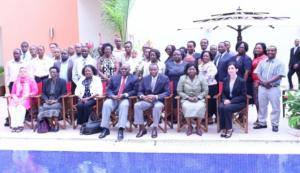The United Republic of Tanzania hosts the human resource for Health Production Plan Workshop: 9th-12th june, 2014.
On the 9th – 12th June, 2014, the Ministry of Health and Social Welfare with support from the World Health Organization, held a stakeholders’ workshop to discuss the Human Resource for Health (HRH) Production Plan in Dar es Salaam. The HRH production plan had three stages; the first stage was the orientation of the methodology and use of the HRH production plan tool which took place early last year, the second stage was the collection of data to feed into the tool which took place in April 2013 and this is the third stage which will process the data in the tool and finally develop the final HRH production plan.
The four days’ workshop officiated by the Chief Medical Officer, Dr. Donnan Mmbando gathered Directors from the Ministry of Health and Social Welfare, Professional Boards, Representatives of Regional and District Medical Officers, Representatives of Academic Institutions, Non-Governmental Organizations and Private Health Facilities. Others present at the meeting were the World Health Organization Representative for Tanzania, Dr. Rufaro Chatora; WHO staff from the Country Office, IST, and HQ; and WHO Consultant, Dr Serpil Nazlioglu.
In his opening address, the Chief Medical Officer expressed his appreciation to the World Health Organization for the technical and financial support throughout the process of developing the HRH Production Plan. He said, “The HRH Production Plan will identify the current and future health workforce needs and accordingly, define health workforce projections for the next 10 years based on realistic and feasible scenarios. The Production Plan will, furthermore, provide inputs into the key policy documents of the Ministry such as Health Sector Strategic Plan IV as well as Human Resource for Health Strategic Plan”. The Chief Medical Officer highlighted the work that has so far been undertaken including: Orientation on the WHO Projection Model tool; Development of a specific framework for data collection and compilation and assessment of the quality of data collected. He urged participants to use the platform to critically deliberate on the policy options to be adopted given the output of the Projection Model.
Dr. Rufaro Chatora, WHO Representative, began his remarks by defining the concept of Universal Health Coverage. He said that Universal Health Coverage means that all people have access to needed quality health services (promotion, prevention, treatment, rehabilitation and palliation), without suffering financial hardship when paying for them. He further elaborated, “The two pillars for universal health coverage are financing and quality health services. Fundamentally, delivering quality health services requires adequate numbers of skilled and motivated health workers. These include service providers such as doctors, pharmacists, nurses, and technologists as well as health managers and support workers”. He called on the workshop participants to discuss not only health workforce issues but also the broader health sector policy directions and targets set for the future development of health services. He concluded that, the HRH production plan will allow the MoHSW to anticipate future production needs and therefore develop financially feasible strategies, and design education investment plans accordingly.
Over the course of four days, participants had an opportunity to:
- Familiarize themselves on the HRH strategic planning and forecasting using the WHO model tool for HRH production plan
- Discuss MOHSW health services development intentions with emphasis on institutional capacity building
- Review and agree on population and demographic forecasts, existing staff supplies and projected future
- staff availability
- Discuss the training capacity requirements and the financial viability of the projected requirements
The following were some of the agreed next steps:
- MOHSW to agree on the recommended Managed PHC scenario
- Finalize the HRH Production Plan based on the recommended scenario
- Integrate the HRH Production Plan into the HRH Strategic Plan
- Ensure alignment of the Comprehensive HRH Strategic Plan with the Health Sector Strategic Plan IV




